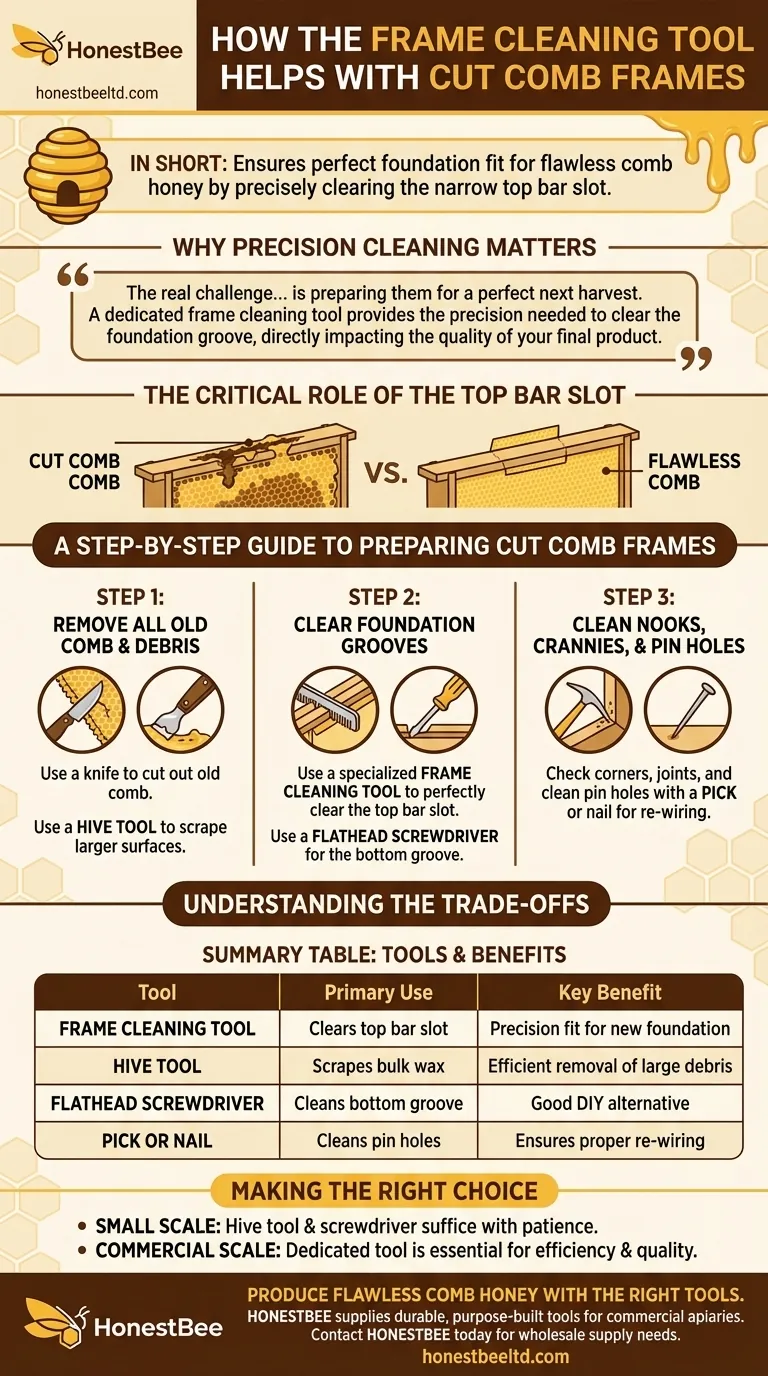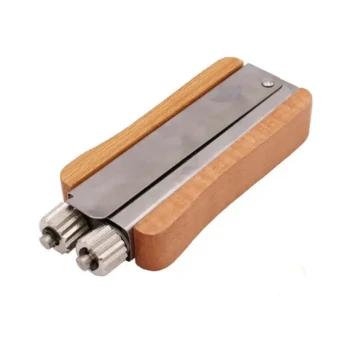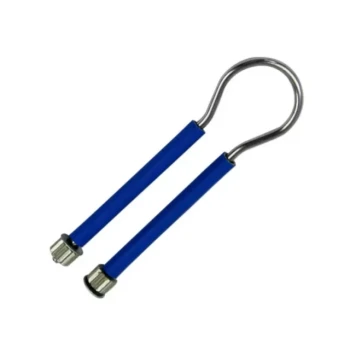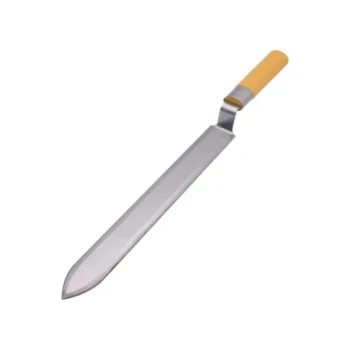In short, the frame cleaning tool is specifically designed to clear wax and propolis from the narrow top bar slot of a cut comb frame. This single, precise action is critical because it ensures a new, thin sheet of foundation can be inserted perfectly, which is the necessary first step for producing flawless comb honey.
The real challenge with cut comb frames isn't just cleaning them, but preparing them for a perfect next harvest. While various tools can scrape a frame, a dedicated frame cleaning tool provides the precision needed to clear the foundation groove, directly impacting the quality of your final product.

Why Precision Cleaning Matters for Cut Comb
Producing high-quality cut comb honey requires the bees to draw out fresh, clean wax on a thin foundation. Unlike standard frames, which are often reused with drawn comb, cut comb frames are reset to zero after each harvest.
The Unique Challenge of Cut Comb Frames
After you harvest the honey by cutting the comb out, the wooden frame remains. Bees will have secured the original foundation and built comb using wax and propolis, leaving significant residue behind.
This residue, especially in the narrow grooves that hold the foundation, prevents a new sheet from sitting flat and secure.
The Critical Role of the Top Bar Slot
The top bar of a cut comb frame has a narrow slot or is fitted with a removable wedge. This is where the new sheet of thin foundation is inserted.
If this slot is clogged with old, hard wax, the new foundation will not fit properly. This can cause it to buckle or sit incorrectly, leading to uneven or poorly built comb by the bees, ultimately ruining the harvest from that frame.
A Step-by-Step Guide to Preparing Cut Comb Frames
While the dedicated tool has one primary job, it's part of a larger process of frame renewal. The goal is to return the wooden frame to a like-new state.
Step 1: Remove All Old Comb and Debris
Using a sharp knife, carefully cut out any remaining sections of comb left in the frame after your main harvest.
Next, use a standard hive tool to scrape the larger surfaces of the frame. This removes the bulk of the wax, any stray burr comb, and sticky propolis from the top, bottom, and side bars.
Step 2: Clear the Foundation Grooves
This is the most critical step for cut comb. Use the specialized frame cleaning tool to run through the top bar slot, clearing it completely of wax. Its shape is designed to fit this groove perfectly without damaging the wood.
For the groove on the bottom bar, a small flathead screwdriver is often effective for scraping out any remaining wax or debris.
Step 3: Clean Nooks, Crannies, and Pin Holes
The frame is not ready until every part is clean. Check the corners and joints for any remaining debris that the hive tool might have missed.
If your frames use wires for support, use a pick or a small nail to clean out the pin holes in the side bars. This ensures you can easily re-wire the frame if needed.
Understanding the Trade-offs: Dedicated Tool vs. DIY
You don't necessarily need to buy a specific tool, but it's important to understand the consequences of the alternatives.
The Case for a Dedicated Tool
A purpose-built frame cleaning tool provides efficiency and precision. It cleans the slot in a single pass, reduces the risk of gouging or damaging the frame, and ensures a uniform channel for the new foundation. For beekeepers processing many frames, the time saved is significant.
When a Screwdriver or Knife Will Suffice
For a hobbyist with only a few cut comb frames, a small flathead screwdriver or the blade of a sturdy knife can do the job.
However, this approach is slower and carries a higher risk of damaging the wood frame. An imperfectly cleaned groove can compromise the final product, making the small investment in a dedicated tool a worthwhile form of quality control.
Making the Right Choice for Your Goal
Your approach to cleaning should align with the scale of your beekeeping operation and your quality standards.
- If your primary focus is harvesting from a few hives: A hive tool and a small flathead screwdriver are sufficient to get the job done with a bit of patience.
- If your primary focus is producing consistent, high-quality cut comb at scale: A dedicated frame cleaning tool is an essential investment that pays for itself in time saved and improved results.
Ultimately, preparing your equipment with care is the first step toward a successful and profitable honey harvest.
Summary Table:
| Tool | Primary Use in Cut Comb Frame Prep | Key Benefit |
|---|---|---|
| Frame Cleaning Tool | Clears wax/propolis from the top bar slot | Precision fit for new foundation |
| Hive Tool | Scrapes bulk wax from frame surfaces | Efficient removal of large debris |
| Flathead Screwdriver | Cleans the bottom bar groove | Good DIY alternative for small-scale use |
| Pick or Nail | Cleans pin holes for wiring | Ensures frames can be properly re-wired |
Produce Flawless Comb Honey with the Right Tools
For commercial apiaries and beekeeping equipment distributors, precision and efficiency are paramount. HONESTBEE supplies the durable, purpose-built tools—like our frame cleaning tools—that are essential for preparing cut comb frames at scale. Ensure every harvest meets the highest quality standards.
Contact HONESTBEE today to discuss your wholesale supply needs and elevate your honey production.
Visual Guide

Related Products
- Precision Stainless Steel Frame Cleaner for Hive Grooves and Corners
- Heavy Duty Stainless Steel Frame Cleaner with Plastic Handle
- Professional Multi-Function Stainless Steel Hive Tool
- Professional 3-Bar Frame Grip with Integrated Hive Tool
- Professional Stainless Steel Pry-Bar Hive Tool
People Also Ask
- What tools are used for cleaning frames? A Beekeeper's Simple 4-Tool Guide
- Why is it important to clean hive tools between uses in different hives? Prevent Disease Spread in Your Apiary
- What are the basic tools for beekeeping? Essential Starter Kit for Safe & Successful Hive Management
- What additional equipment can be used in beekeeping besides the basic hive components? Essential Gear for Every Beekeeper
- How do you clean hive frames? A Guide to Routine Scraping vs. Deep Sterilization



















